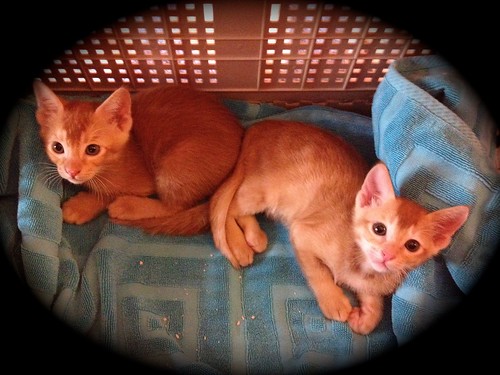As the school year winds down, international teachers say a lot of farewells. Many of our friends and colleagues will depart for new adventures, and it’s hard to say good-bye. So we procrastinate. We drag it out. We have parties and dinners and weekend get-aways to stall the inevitable. In that spirit, a group of us took off for Kathmandu, Nepal, the last weekend in April to celebrate two ladies who will leave Delhi at the end of the school year – Katrina and Shannon.
In case you didn’t know, Nepal is the only country with a flag that is NOT a rectangle:
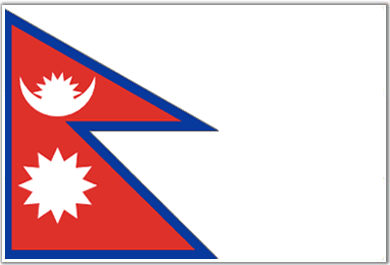
An early morning flight on Friday got us to the Kathmandu Guest House before lunch. I’ve actually outgrown guest houses, but this one came recommended, looked good online and, hey, it was good enough for the Beatles in 1968. As we settled in among the throngs of backpackers and trekkers, we realized the website may have exaggerated a bit. I awoke early each day to sip coffee and read my book in the guesthouse’s peaceful courtyard cafe, which was full of flowers and fountains. Outside the gate, however, the narrow streets clogged with tourists and traffic.
Inside the Kathmandu Guesthouse gate
(Photo by Katrina)
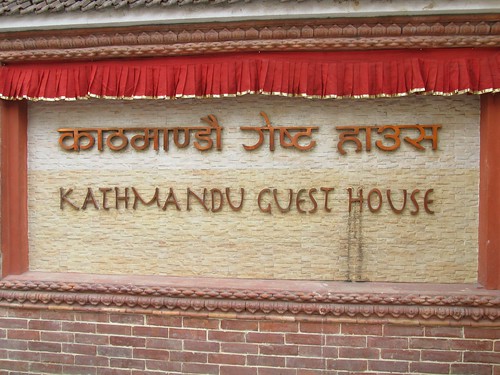
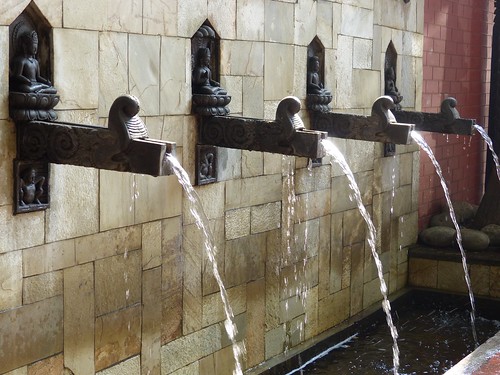
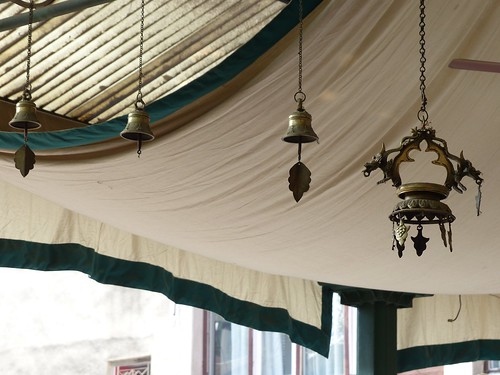

There were several of these statues with monkeys clinging to their wieners. I’m sure there must be a reason for it, but my research has yielded nada.
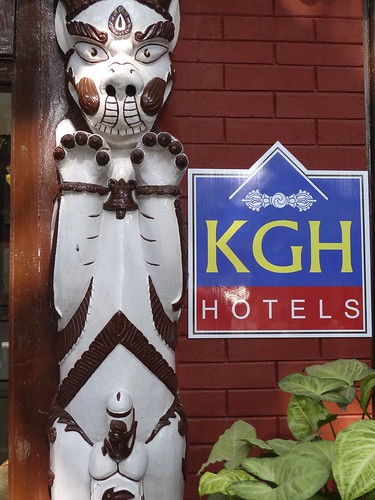
Outside the Kathmandu Guest House gate
(photo by Tammy)
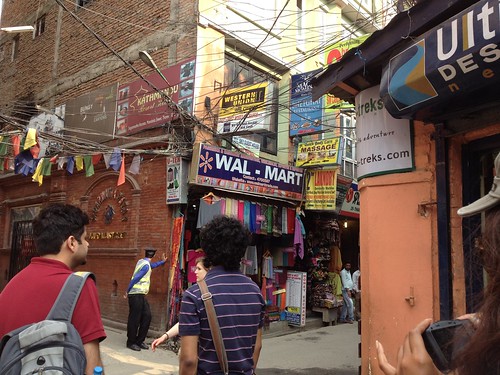
(3 photos by Katrina)
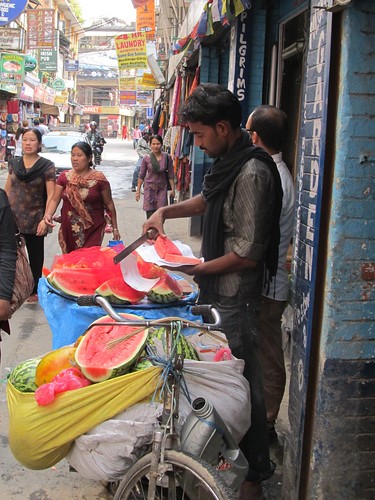
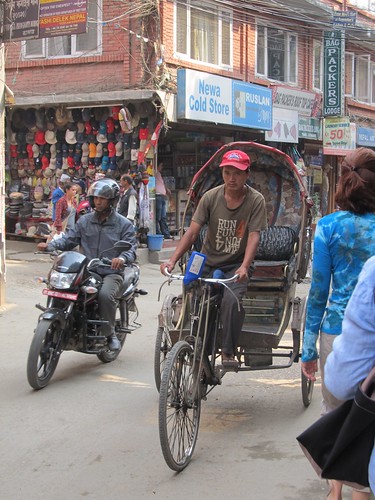
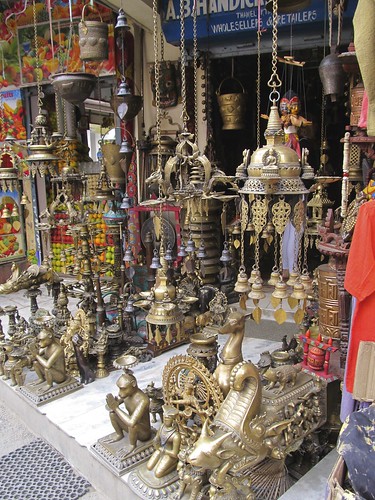
Bhaktapur – UNESCO World Heritage Site
(Everything that sounds factual in this section comes from the book Discovering Bhaktapur – A Guide to the Historic Newar City, which I found in pdf form online. So interesting! Now that I’ve read up on this place, I need to return and see everything I missed.)
Saturday morning, we took a car about 20 kilometers to the ancient town of Bhaktapur, which was one of three independent kingdoms in the Kathmandu Valley about 300 years ago. The city declined after unification in the late 1700s, and a massive earthquake in 1934 damaged or destroyed most homes and temples. Germany was instrumental in helping rebuild and revitalize Bhaktapur through a major project that tackled restoration of historic and religious monuments, the water and sewer infrastructure, health education, land development and housing, schools and more through the late 1980s. The rise in tourism has also renewed interest in conserving its unique culture, architecture and handicrafts.
At the entrance to Bhaktapur, we bought a ticket and hired a guide, Shyam.
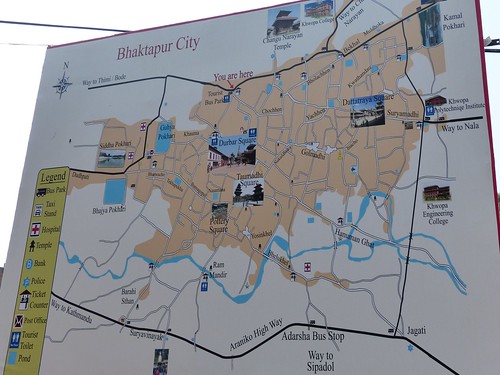
Pausing so Shyam can tell us about Durbar Square.
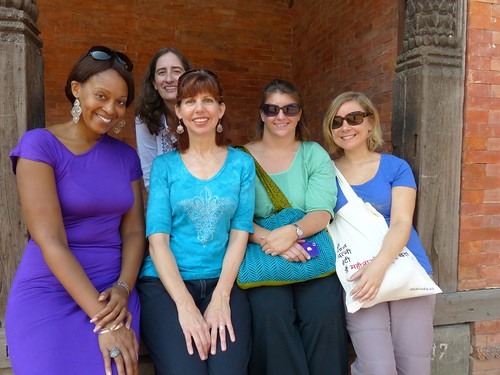
Shyam stands at the Golden Gate, the entrance to the religious areas of the royal palace.
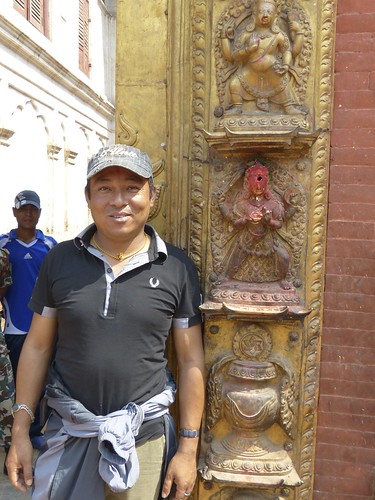
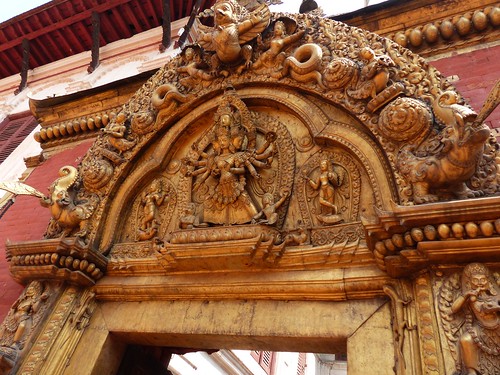
He explains that some of the wood carvings are original and others were created during the restoration.
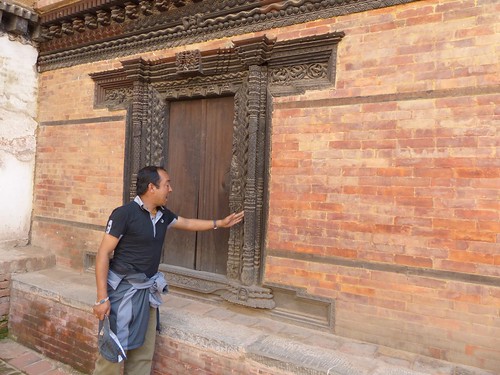
Only Hindus were allowed into Mul Chowk, home of the most holy temple of Taleju, the goddess worshipped by the royal family. We could, however, visit Naga Pokhari, a royal bath guarded by the gilded snake god Vasuki. I climbed down to check out the strange water spout. According to my book, such taps are typical of the era.
The spout itself is usually in the form of a makara, a mythical water creature that seems like a cross between a crocodile and an elephant. It is the vehicle of the water god Varuna. It often has a fish emerging from its mouth.
This one had a goat emerging from its mouth and a web-footed rat-like thing on its back.
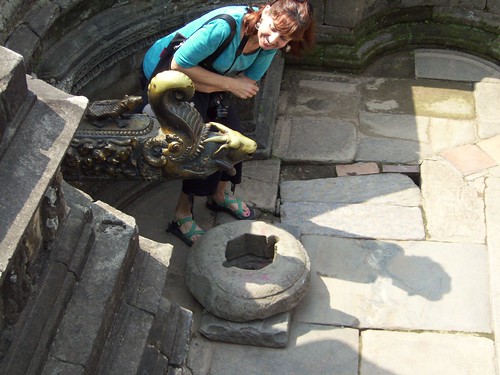
Facing the Golden Gate is the king who built it, Bhupatindra Malla (1696-1722), sitting atop a tall pillar. The statue was constructed in 1753 by his son, the last king of Bhaktapur.
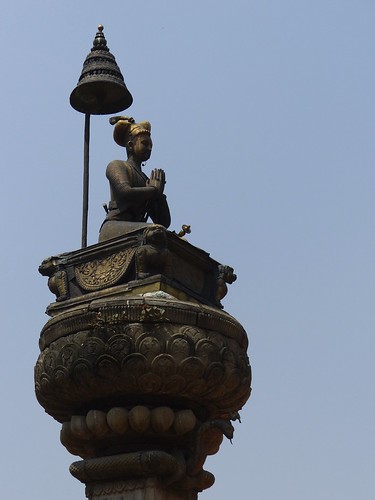
The Yaksheswar Mahadev Temple, dedicated to Shiva and dating back to the 1450s, features many erotic woodcarvings. Shyam said they represent the 24 sexual positions guaranteed to produce a son. “I know in Europe they have more than 24 positions, but here we have only 24,” he said with a laugh. My handy book says the carvings are actually associated with religious tantric cults of that time.
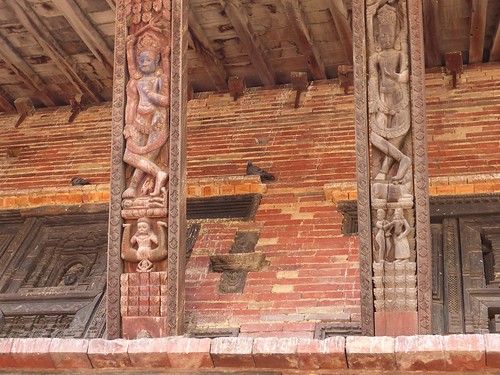
This whimsical little temple is dedicated to Siddhilaxmi, the goddess of success. My book says,
It has a delightful series of figures guarding its steps: a couple of chained rhinos (suggesting that the Mallas perhaps kept a menagerie), a pair of camels and what appears to be two naughty boys refusing to accompany their mothers.
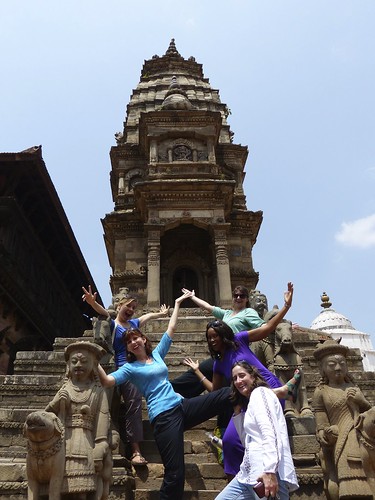
Another little temple.
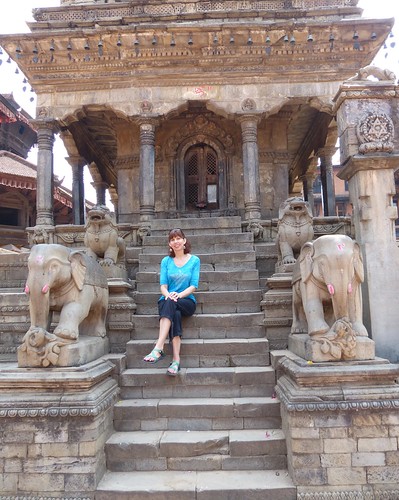
The Nyatapola Temple is the 30 meter-high pagoda in Taumadi Square. More from my book:
It’s thought to be dedicated to the beautiful goddess Siddhilaxmi and only special Taleju priests are allowed secret access to the inner sanctum. Nobody else worships there. It was built on the orders of Bhupatindra Malla in 1702. It is said that he set a fine example by carrying the first three bricks on his shoulder. This so inspired the population that all the remaining materials were brought up in the following five days. … Guarding the temple are ten mighty figures. At the bottom are two local wrestling champions called Jayamala and Patta. Next up, ten times stronger, are a pair of elephants. Then two lions, two griffins (sarduls) and two deities, Singhini and Byanghini. Each is ten times stronger than the pair below.
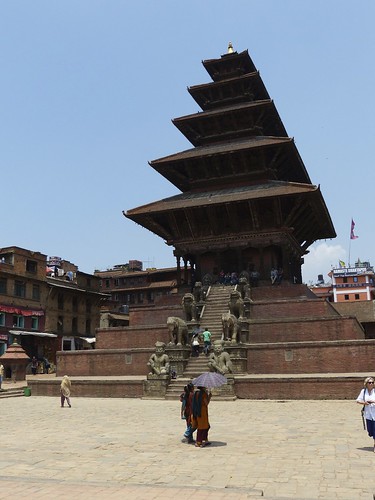

View from the top.

According to Shyam, this “vehicle” plays an exciting part in a big religious festival, sort of a tug-of-war thing to carry an image of the god Bhairav to meet up with the goddess Bhadrakali for a fertility ritual.
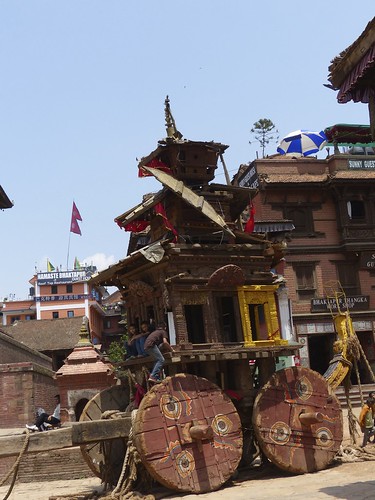
My book says those rickety wheels inevitably crush raucous festival-goers.
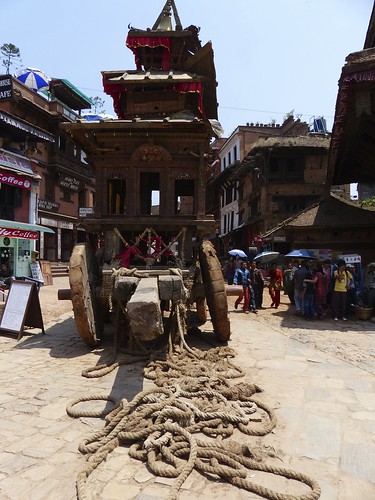
Shyam led us through a rabbit warren of alleys, where we witnessed the daily rituals of life: ladies drawing water from the wells, grannies minding toddlers and goats, workers hauling loads of timber and bricks, craftsmen carving wood and throwing pots, old men bent over a card table, children kicking around a ball or rolling a tire, vendors selling a little bit of everything. Here’s an interesting tidbit from my book:
The ancient route from Delhi and Kathmandu to Lhasa and Beijing went through Bhaktapur. A steady trade was maintained in salt, wool, gold dust, copper, medicinal herbs, spices and yak tails (used as royal fly whisks). Probably not much silk though. This trade peaked in the early 18th century and then declined after the national unification in 1767. A community of Newari traders has remained in Lhasa to import Nepali goods up to the present time.

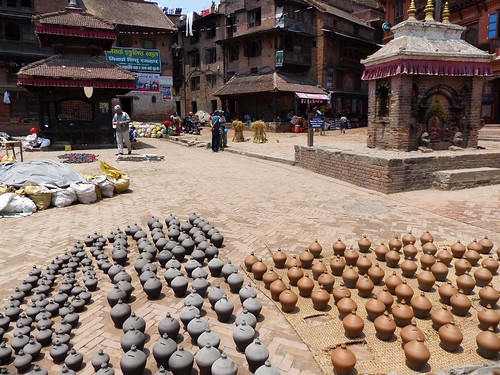
“Weighing” chickens for sale.
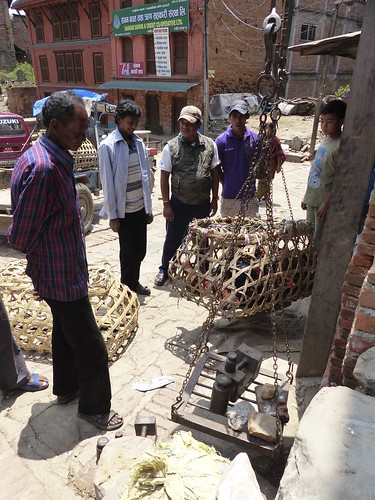


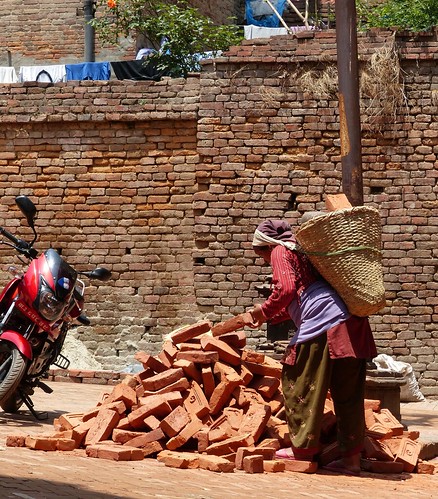
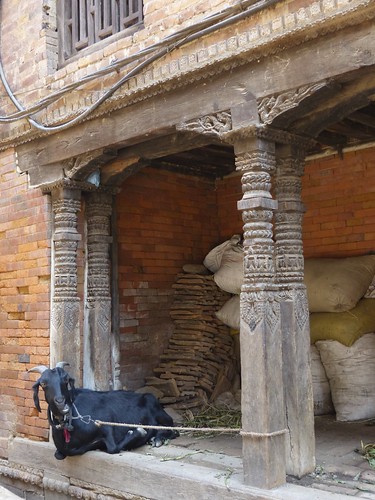
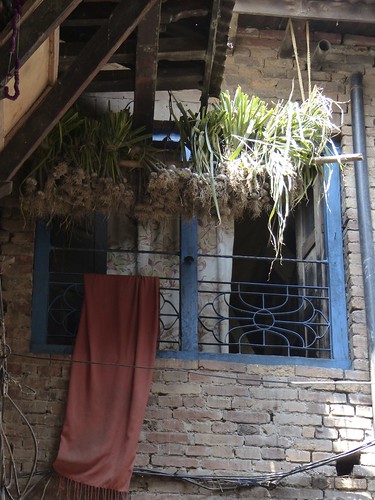
The famous Peacock Window.
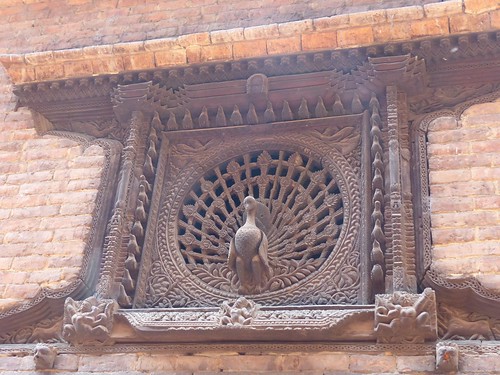
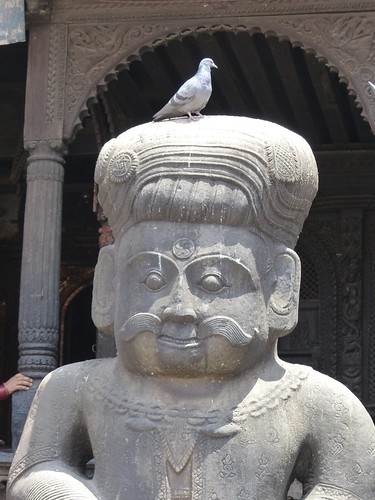
During our tour of Bhaktapur, Shyam took us to the Lama Thanka Painting School. We learned about the Dalai Lama’s sand mandala design.

According to the Namgyal Monastery Institute of Buddhist Studies,
Sand mandalas are one of the most magnificent types of mandala construction and are associated with the most profound and elaborate Buddhist ceremonies in Tibet. Every color, dot, and line in the mandala represents an essential part of the deity and Buddhist philosophy. Each component must be placed in exactly the same place every time the mandala is constructed.
Although sand mandalas are made on a flat surface they are, to the devout, a three dimensional palace, representing the mind of the Buddha. The person contemplating the mandala enters into it, as they would a building or an enclosure.
The mandala construction itself is the result of long and disciplined effort, but it is nonetheless a temporary work. When the monks are finished, there is a dissolution ceremony where the deity is released by the dismantling of the mandala. The sand is cast into a body of water to emphasize and highlight the impermanence of all things and the importance of nonattachment. When the sand enters the water, the kindness and compassion of the deity are disseminated into the world to benefit all beings.

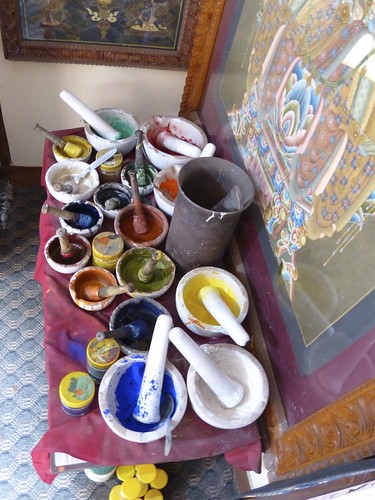
Then, of course, we started looking at paintings by students and masters, and then, of course, we couldn’t resist buying some. They really are stunning. Mine features a favorite mantra of compassion – om mani padme hum – painted in gold gajillions of times in concentric circles.

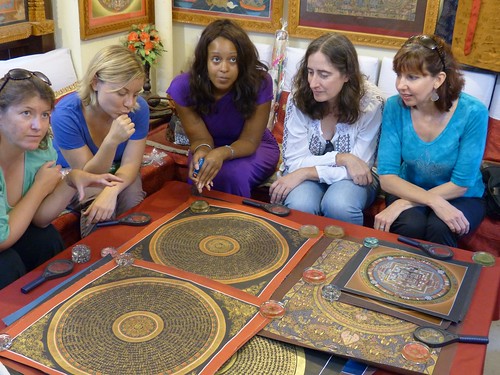
We had a fascinating day with Shyam.

Before leaving Bhaktapur, we ate lunch at the redundantly named Cafe de Traditional Restaurant. I’m not sure what we ate, but I assure you it was delicious!
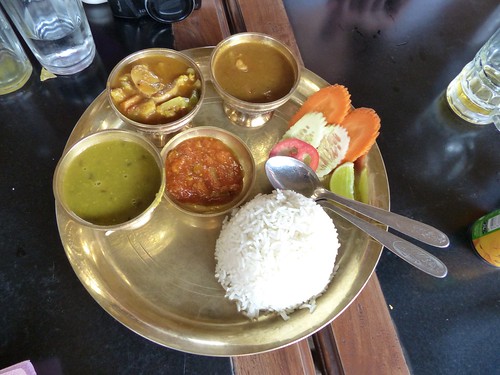
The best part was dessert: King’s Curd, a sweet scrumptious yogurty treat. Katrina took this shot of me loving my King’s Curd.

This little girl watched us eat. Katrina’s pic.
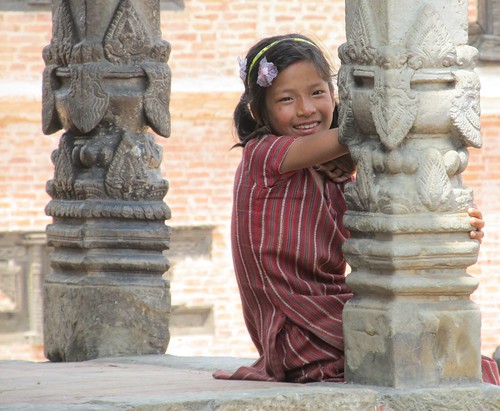
These guys were our waiters.
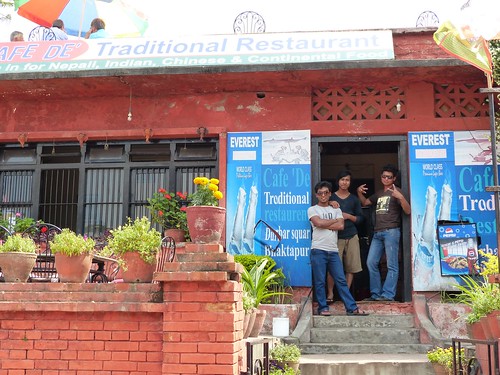
Back in Thamel, the backpacker part of Kathmandu, we popped into a Mexican restaurant for margaritas. I hung my camera, purse and bag of bananas on the back of my chair. (That detail will become important later.) We enjoyed a little siesta and then took off for a spectacular French dinner at Chez Caroline. Yes, before we left Kathmandu, we had devoured Italian, Mexican, French and Nepalese cuisine, including more than our fair share of momos.
In the morning, I wandered down to the courtyard for coffee but felt like something was amiss, you know, that feeling you get just after shutting the front door and realizing you don’t have your keys? I read my book for awhile, uneasy but unable to figure out why. Finally, I realized I hadn’t seen my camera that morning. I knew I had taken it to the Mexican restaurant, but I couldn’t remember having it after that. I wandered over to the restaurant and shook the metal grate over the door until a cleaning lady popped her head out the window. She came downstairs and let me in to search. No luck. One of the waiters shook his head. There were really only two possibilities: Another diner stole it or a staff member found it.
The camera had been an expensive Christmas present to myself (although Tony technically made the amazon.com purchase and put it under the tree). I was already mourning the loss, but even more, I was kicking myself for losing all the photos from this trip. Back at the guesthouse, Katrina wasn’t feeling well, so she stayed in bed while the rest of us headed out on another excursion.
Bouddhanath Stupa
The Bouddhanath Stupa, first built in the 14th century, is one of the holiest Buddhist sites in Nepal and one of the largest stupas in the world. It was declared a UNESCO World Heritage site in 1979. As usual, one of my favorite travel websites – Sacred Destinations – has an excellent write-up about the stupa.
From above, Bodnath Stupa looks like a giant mandala, or diagram of the Buddhist cosmos. And as in all Tibetan mandalas, four of the Dhyani Buddhas mark the cardinal points, with the fifth, Vairocana, enshrined in the center (in the white hemisphere of the stupa). The five Buddhas also personify the five elements (earth, water, fire, air and ether), which are represented in the stupa’s architecture.
There are other symbolic numbers here as well: the nine levels of Boudhanath Stupa represent the mythical Mt. Meru, center of the cosmos; and the 13 rings from the base to the pinnacle symbolize the path to enlightenment, or “Bodhi” — hence the stupa’s name.
At the bottom, the stupa is surrounded by an irregular 16-sided wall, with frescoes in the niches. In addition to the Five Dhyani Buddhas, Boudhanath Stupa is closely associated with the Bodhisattva Avalokiteshvara (Padmapani), whose 108 forms are depicted in sculptures around the base. The mantra of Avalokiteshvara – Om Mani Padme Hum – is carved on the prayer wheels beside the images of Avalokiteshvara around the base of the stupa.
The base of the stupa consists of three large platforms, decreasing in size. These platforms symbolize Earth, and here you can look out at the mountains while listening to the chants of the devout doing kora, walking around the stupa praying.
Next come two circular plinths supporting the hemisphere of the stupa, symbolizing water. As at Swayabunath, Bodnath is topped with a square tower bearing the omnipresent Buddha eyes on all four sides.
Instead of a nose is a question-mark-type symbol that is actually the Nepali character for the number 1, symbolizing unity and the one way to reach enlightenment—through the Buddha’s teachings. Above this is the third eye, symbolizing the wisdom of the Buddha.
The square tower is topped by a pyramid with 13 steps, representing the ladder to enlightenment. The triangular shape is the abstract form for the element of fire. At the top of the tower is a gilded canopy, the embodiment of air, with above it a gilded spire, symbolic of ether and the Buddha Vairocana. Prayer flags tied to the stupa flutter in the wind, carrying mantras and prayers heavenward.
The main entrance to the upper platform of Bodnath Stupa is on the north side. Here Amoghasiddhi, progenitor of the future Buddha, presides. Below Amoghasiddhi is the Buddha Maitreya, the future Buddha.
Surrounding Boudhanath Stupa are streets and narrow alleys lined with colorful homes, Tibetan Buddhist monasteries, and street vendors.
Buddhism is my go-to religion in times of strife. I like the mantras, the rituals, the karma. So I decided to follow the pilgrims on the circumambulatory path, turning every one of the prayer wheels while chanting the mantra adorning each one: om mani padme hum.
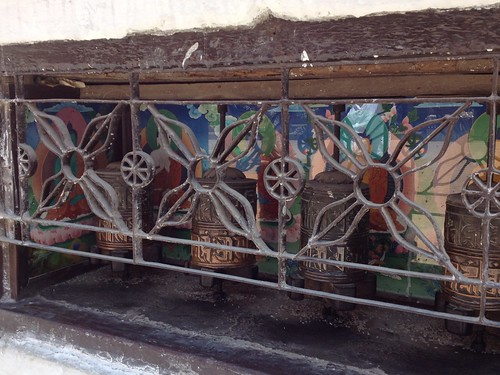
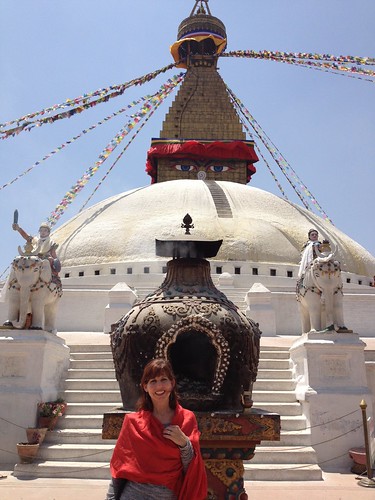
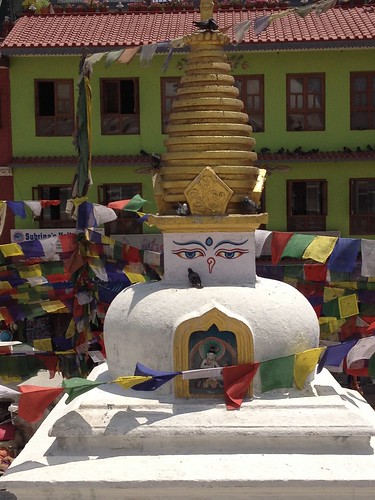
All of us gave a donation to a monk at the stupa in exchange for a blessing. The monk wrote the mantra on paper, folded it, wrapped it in colored thread and then blessed it.
(Photo by Tammy)
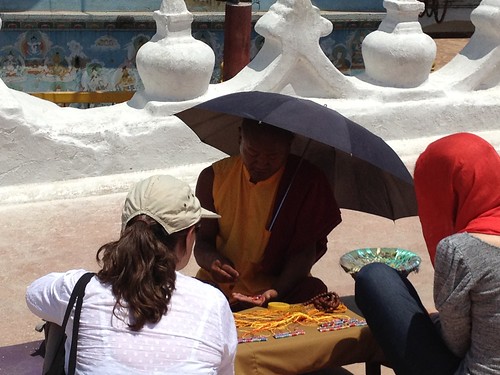
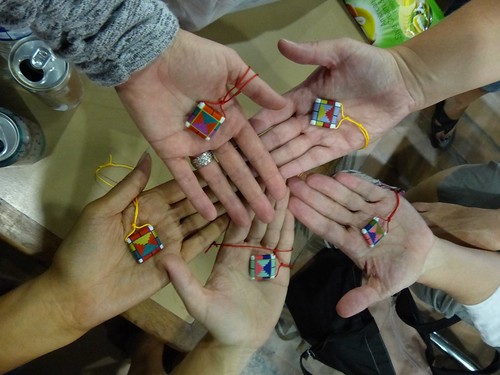
We climbed up to a rooftop cafe for a quiet break (and a good view of what seemed to be the filming of a cheesy music video) before heading back to our guesthouse.
(Photo by Tammy)
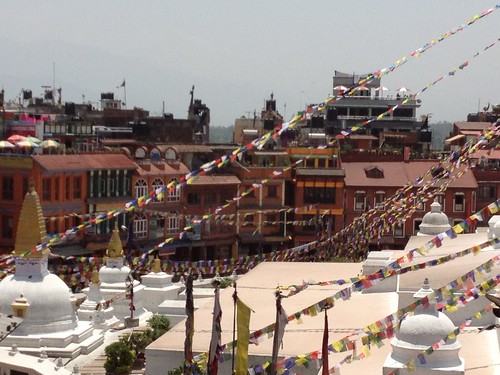
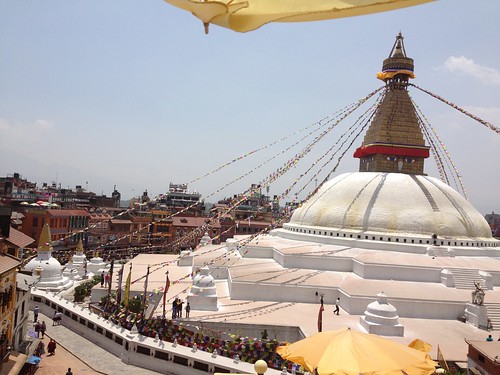
Well, I don’t know if it was the prayer wheels, the monk’s mantra necklace, Katrina’s rise from her sickbed to give the stink-eye to the workers at the Mexican restaurant or just dumb luck, but when we got back to Thamel, I ran up the stairs to the restaurant and the bartender said, “We found your camera! We already returned it to your guesthouse!” All’s well that ends well.
And that’s the end. We packed a LOT into a short girls get-away. Ladies, I’m gonna miss you!
